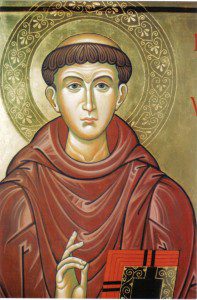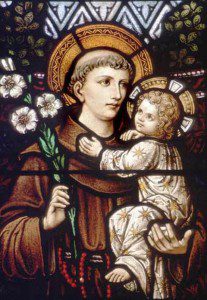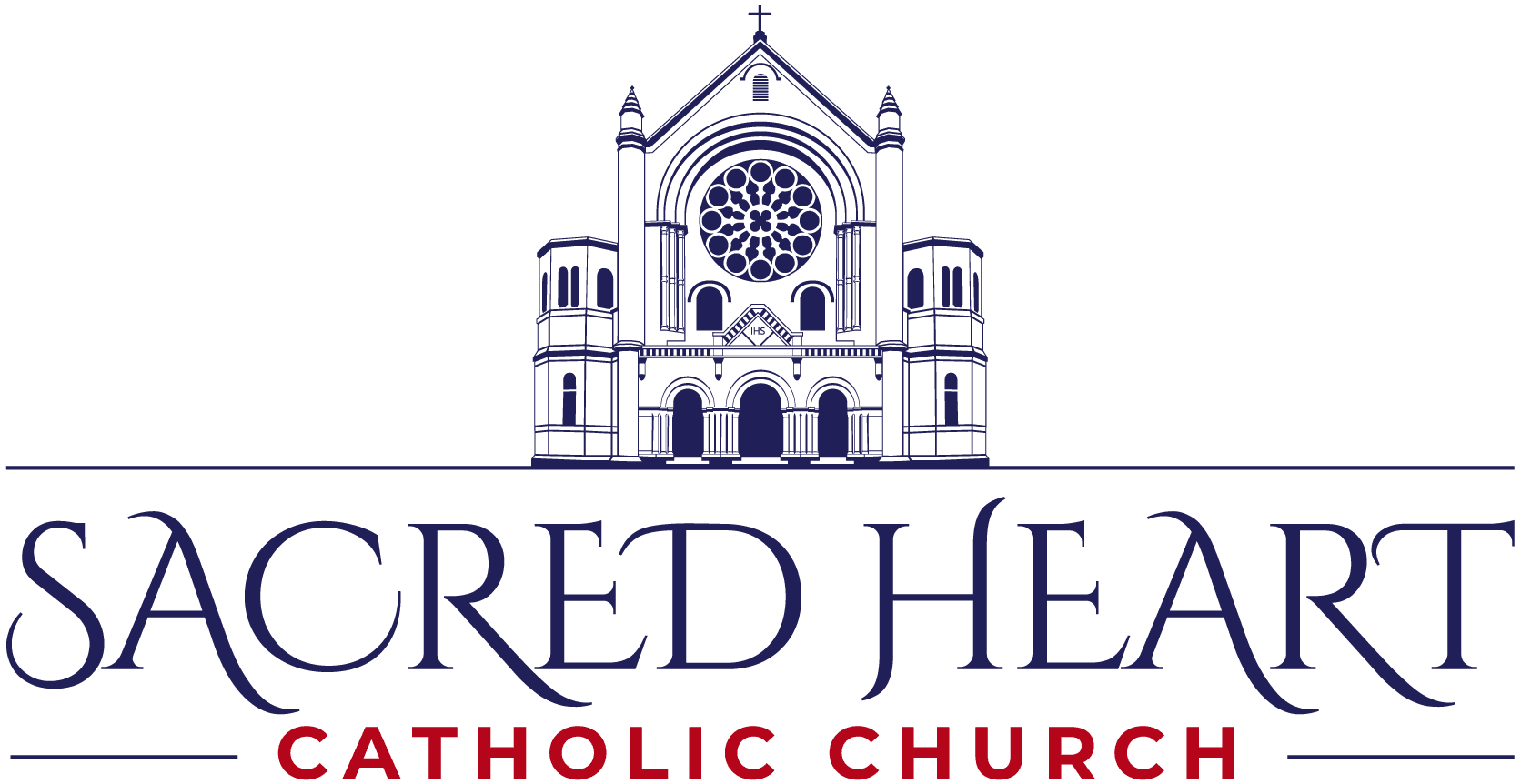The Feast of St. Anthony of Padua: June 13th
 Saint Anthony of Padua
Saint Anthony of Padua
When we Franciscans arrived at Sacred Heart in 2005, we were quite surprised to find that one of the clerestory windows (the ones up high in the nave vault) was Saint Anthony of Padua, a Franciscan contemporary of St. Francis of Assisi. In fact, we Franciscans still have a brief letter, in Francis’ own hand, written to Anthony. Most people know St. Anthony of Padua as the patron saint of lost and stolen articles, but have you ever wondered why he is that particular patron saint?
The Patron Saint of Lost Things.
The reason for invoking St. Anthony’s help in finding lost or stolen things is traced back to an incident in his own life. As the story goes, Anthony had a book of psalms that was very important to him. You have to remember this was before the age of the printing press and so all books were of great value, and besides the value of the book, the psalter had the notes and comments he had made to use in teaching students in his Franciscan Order.
A novice who had already grown tired of living religious life decided to depart the community. Besides going AWOL, he also took Anthony’s psalter! Upon realizing his psalter was missing, Anthony prayed it would be found or returned to him, and after his prayer the thieving novice was moved to return the psalter to Anthony and to return to the Order, which accepted him back. Legend has embroidered this story a bit. It has the novice stopped in his flight by a horrible devil, brandishing an ax and threatening to trample him underfoot if he did not immediately return the book. Obviously a devil would hardly command anyone to do something good, but the core of the story would seem to be true. The stolen book is said to be preserved in the Franciscan friary in Bologna.
In any event, shortly after his death people began praying through Anthony to find or recover lost and stolen articles. And the “Responsory of St. Anthony” composed by his contemporary and brother friar, Julian of Spires, proclaims, “The sea obeys and fetters break/And lifeless limbs thou dost restore/While treasures lost are found again/When young or old thine aid implore.”
Before He Was Anthony of Padua
Anthony of Padua was born Fernando Martins de Bulhões on August 15, 1195 in Lisbon, Portugal. His was in a very rich family of the nobility who wanted him to become educated, and they arranged for him to be instructed at the local cathedral school. Against the wishes of his family, however, at the age of 15 he entered the community of Canons Regular at the Abbey of St. Vincent on the outskirts of Lisbon. Monastery life was hardly peaceful for young Fernando, nor conducive to prayer and study, as his old friends came to visit frequently and engaged in vehement political discussions.
But the Canons were famous for their dedication to scholarly pursuits, and seeing the potential in young Fernando, they sent the youth to their major center of studies, the Abbey of the Holy Cross in Coimbra. There the young Fernando studied theology and Latin. He began nine years of intense study, learning the Augustinian theology that he would later combine with the Franciscan vision.
Joining the Franciscans
After his ordination to the priesthood, Fernando was named guestmaster and placed in charge of hospitality for the abbey. It was in this capacity, in 1219, that he came into contact with five Franciscan friars who were on their way to Morocco to preach the Gospel to the Muslims there. Fernando was strongly attracted to the simple, evangelical lifestyle of the friars, whose order had been founded only eleven years prior. In February of the following year, news arrived that the five Franciscans had been martyred in Morocco, the first to be killed in their new order.
Seeing their bodies as they were processed back to Assisi, Fernando meditated on the heroism of these men; inspired by their example, and longing for the same gift of martyrdom, he obtained permission from church authorities to leave the Augustinian Canons to join the new Franciscan Order. Upon his admission to the life of the friars, he joined the small hermitage in Olivais, adopting the name Anthony (from the name of the chapel located there, dedicated to Saint Anthony the Great), by which he was to be known.
Brother Anthony then set out for Morocco, in fulfillment of his new vocation. Illness, however, stopped him on his journey. At this point, he decided to head to Italy, the center of his new order.
Finding His Place Among the Franciscans
On the voyage there, his ship was driven by a storm onto the coast of Sicily and he landed at Messina. From Sicily he made his way to Tuscany where he was assigned to a house of the order, but he met with difficulty on account of his sickly appearance. He was finally assigned, out of pure compassion, to the rural hospice of San Paolo near Forlì, Romagna, a choice made after considering his poor health. There he appears to have lived as a hermit and was put to work in the kitchen, while being allowed to spend much time in private prayer and study.
One day, on the occasion of an ordination, a great many visiting Dominican friars were present, and there was some misunderstanding over who should preach. The Franciscans naturally expected that one of the Dominicans would occupy the pulpit, for they were renowned for their preaching; the Dominicans, on the other hand, had come unprepared, thinking that a Franciscan would be the homilist. In this quandary, the head of the hermitage, who had no one among his own humble friars suitable for the occasion, called upon Anthony, whom he suspected was most qualified, and entreated him to speak whatever the Holy Spirit should put into his mouth.
Anthony objected but was overruled, and his sermon created a deep impression. Not only his rich voice and arresting manner, but the entire theme and substance of his discourse and his moving eloquence, held the attention of his hearers.
At that point, Anthony was commissioned by Brother Gratian, the local Minister Provincial, to preach the Gospel throughout the area of Lombardy, in northern Italy. In this capacity he came to the attention of the founder of the order, Francis of Assisi.
Public Preacher, Franciscan Teacher
Anthony’s superior, St. Francis, was cautious about education such as his protégé possessed. He had seen too many theologians taking pride in their sophisticated knowledge leading to an abandonment of their commitment to a life of real poverty. In Anthony, however, he found a kindred spirit for his vision, who was also able to provide the teaching needed by young members of the order who might seek ordination. Francis wrote in 1224, “It pleases me that you should teach the friars sacred theology, provided that in such studies they do not destroy the spirit of holy prayer and devotedness, as contained in the Rule.” He thereby entrusted the pursuit of studies for any of his friars to the care of Brother Anthony. From then on his skills were used to the utmost by the Church. Occasionally he took another post, as a teacher, for instance, at the universities of Montpellier and Toulouse in southern France, but it was as a preacher that Anthony revealed his supreme gift.
Anthony first taught in a friary in Bologna, which became a famous school. The theology book of the time was the Bible. In one extant sermon by the saint, there are at least 183 passages from Scripture. While none of his theological conferences and discussions were written down, we do have two volumes of his sermons: Sunday Sermons and Feast day Sermons. His method included much of allegory and symbolical explanation of Scripture.
Anthony continued to preach as he taught the friars and assumed more responsibility within the Order. In 1226 he was appointed provincial superior of northern Italy, but still found time for contemplative prayer in a small hermitage. Around Easter in 1228 (he was only 33 years old), while in Rome, he met Pope Gregory IX, who had been a faithful friend and adviser of St. Francis. Naturally, the famous preacher was invited to speak. He did it humbly, as always. The response was so great that people later said that it seemed the miracle of Pentecost was repeated.
Despite his efforts, not everyone listened. Legend has it that one day, faced with deaf ears, Anthony went to the river and preached to the fishes. That, reads the traditional tale, got everyone’s attention.
Death
Anthony became ill with edema and, in 1231, went to the woodland retreat at Camposampiero with two other friars for a respite. There, Anthony lived in a cell built for him under the branches of a walnut tree. Anthony died on the way back to Padua on June 13, 1231 at the Poor Clare monastery at Arcella (now part of Padua), aged 36.
Various legends surround the death of Anthony. One holds that when he died, the children cried in the streets and that all the bells of the churches rang of their own accord. Another legend regards his tongue. Anthony is buried in a chapel within the large basilica built to honor him, where his tongue is displayed for veneration in a large reliquary. When his body was exhumed thirty years after his death, it was found to have returned to dust, but the tongue was claimed to have glistened and looked as if it was still alive and moist; apparently a further claim was made that this was a sign of his gift of preaching.
Teacher, Preacher, Doctor of the Scriptures
Among the Franciscans themselves and in the liturgy of his feast, St. Anthony is celebrated as a teacher and preacher extraordinaire. He was the first teacher in the Franciscan Order, given the special approval and blessing of St. Francis to instruct his brother Franciscans. His effectiveness as a preacher calling people back to the faith resulted in the title “Hammer of Heretics.” Just as important were his peacemaking skills and calls for justice.
In canonizing Anthony in 1232, Pope Gregory IX spoke of him as the “Ark of the Testament” and the “Repository of Holy Scripture.” That explains why St. Anthony is frequently pictured with a burning light or a book of the Scriptures in his hands. In 1946, Pope Pius XII officially declared Anthony a Doctor of the Universal Church. It is in Anthony’s love of the word of God and his prayerful efforts to understand and apply it to the situations of everyday life that the Church especially wants us to imitate St. Anthony. While noting in the prayer of his feast Anthony’s effectiveness as an intercessor, the Church wants us to learn from Anthony, the teacher, the meaning of true wisdom and what it means to become like Jesus, who humbled and emptied himself for our sakes and went about doing good.
Miracles and Traditions of St. Anthony
St. Anthony Bread is a term used for offerings made in thanksgiving to God for blessings received through the prayers of St. Anthony. Sometimes the alms are given for the education of priests. In some places parents also make a gift for the poor after placing a newborn child under the protection of St. Anthony. It is a practice in some churches to bless small loaves of bread on the feast of St. Anthony and give them to those who want them.
Different legends or stories account for the donation of what is called St. Anthony Bread. By at least one account it goes back to 1263, when it is said a child drowned near the Basilica of St. Anthony, which was still being built. His mother promised that if the child was restored to her she would give for the poor an amount of corn equal to the child’s weight. Her prayer and promise were rewarded with the boy’s return to life.
Another reason for the practice is traced back to Louise Bouffier, a shopkeeper in Toulon, France. A locksmith was prepared to break open her shop door after no key would open it. Bouffier asked the locksmith to try his keys one more time after she prayed and promised to give bread to the poor in honor of St. Anthony if the door would open without force. The door then opened. After others received favors through the intercession of St. Anthony, they joined Louise Bouffier in founding the charity of St. Anthony Bread.
 St. Anthony and the Child Jesus
St. Anthony and the Child Jesus
St. Anthony has been pictured in all kinds of ways by artists and sculptors. He is depicted with a book in his hands, with a lily or torch. He has been painted preaching to fish, holding a monstrance with the Blessed Sacrament in front of a mule or preaching in the public square or from a nut tree.
But since the 17th century, we most often find the saint shown with the child Jesus in his arm or even with the child standing on a book the saint holds. A story about St. Anthony related in the complete edition of Butler’s Lives of the Saints (edited, revised and supplemented by Herbert Anthony Thurston, S.J., and Donald Attwater) projects back into the past a visit of Anthony to the Lord of Chatenauneuf. Anthony was praying far into the night when suddenly the room was filled with light more brilliant than the sun. Jesus then appeared to St. Anthony in the form of a little child. Chatenauneuf, attracted by the brilliant light that filled his house, was drawn to witness the vision but promised to tell no one of it until after St. Anthony’s death.
St. Anthony and the Lily
Most images of St. Anthony of Padua depict him holding the Child Jesus and with lilies. It has been a part of tradition in Christian art to use lilies as a symbol of purity when portraying Our Lady or the Saints and even Angels.
With St. Anthony, lilies have special significance. Lilies are in bloom around much of the world in the month of June, the month of his Feast Day [the 13th]. Of even more import there are two incidents hundreds of years old relating to the Saint of Padua and these magnificent flowers.
In 1680, on June 13th, in the church at Mentosca d’Agesco in Austria, someone placed a cut lily in the hand of his statue. For an entire year the lily remained fragrant and fully alive, without wilting. Then the following year it grew two more blooms, so that the church was filled with the fragrance of the flowers.
A little over a century later, during the anti-clerical, anti-Catholic French Revolution, on the island of Corsica, the Franciscans were forced to leave their parishioners. The people refused to give up their devotions, although they had no choice in the matter of the Sacraments because they had no priests. They invoked the intercession of St. Anthony. On June 13th, they erected a shrine to the Saint in the deserted church; the shrine included lilies in his honor. Months later the blooms were still fresh as if they had just been placed there.
Permission to bless lilies in honor of the Saint was given by Pope Leo XIII. Many favors have been granted through this devotion, such as help to the sick who have been touched by the petals of the blessed flowers.





